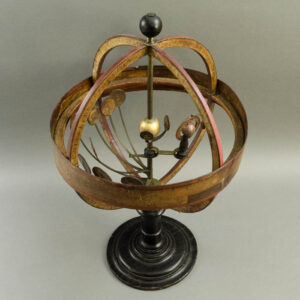Description
Demonstrational armillary spheres were commonly produced in France in the 18th and 19th centuries to show various basic principles of astronomy. An armillary sphere with the earth at the center is known as Ptolemaic, and an armillary sphere with the sun at the center is known as Copernican. Ptolemy (2nd Century A.D), an Alexandrian astronomer believed that the earth was at the center of the universe. Ptolemaic armillary spheres were produced in Islamist countries, reaching advanced levels as early as the 10th century.
The Delamarche family and successors were the most renowned and prolific producer of armillary spheres in France from the late 18th century to the late 19th century. The terrestrial globe on the offered sphere has the Charles-François Delamarche company cartouche with the address of Rue du Foin St. Jacques, where the firm was located until it moved in 1805. The design overall, with its slightly oblong lower quadrant supports, closely resembles one pictured in Lamb & Collins dated c. 1780 (see References below). In Globes of the Western World, Dekker and van der Krogt explain that Charles-François Delamarche was the first person in France to create globes for the general public, constructing his armillary spheres in such a manner as to keep them affordable.
Read more about Delamarche in our Guide to Globe Makers.
Round Cartouche on Globe: “GLOBE TERRESTRE./ A PARIS,/ chez Delamarche Géog./ r[u]e du Foin [St.] Jacques/[a]u Collège de M’e. Gervais.”
Condition: Terrestrial globe very good, brighter and clearer than generally encountered for an armillary sphere, but nonetheless with the usual overall toning, wear, fading. Sphere rings generally very good, with the usual expected light toning, wear, discoloration and darkening, soiling and handling, warping. Most lettering is readable. Stand with the usual overall light wear and shrinkage.
References:
Dekker, Elly, et al. Globes at Greenwich: A Catalogue of the Globes and Armillary Spheres in the National Maritime Museum, Greenwich. London: Oxford University Press and the National Maritime Museum, 1999. p. 321.
Dekker, Elly and van der Krogt, Peter. Globes from the Western World. London: Zwemmer, 1993. pp. 62-63, Plate 15.
Khan, Samia. The Armillary Sphere: A Concentrate of Knowledge in Islamic Astronomy. Manchester, UK: FSTC Ltd., December 2007. pp. 2-13.
Lamb, Tom and Collins, Jeremy. The World in Your Hands: An Exhibition of Globes and Planetaria. London: Christie’s, 1994. pp. 50-51, item 4.32.









